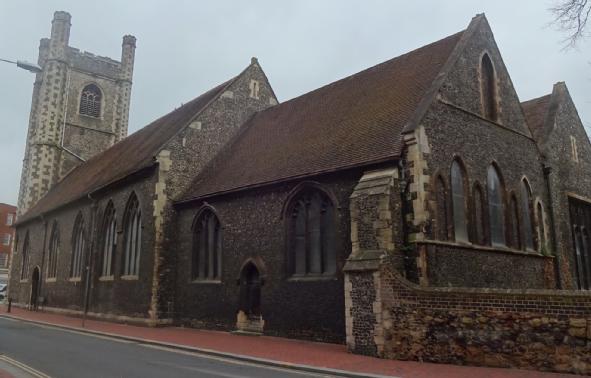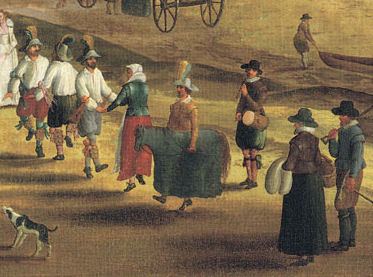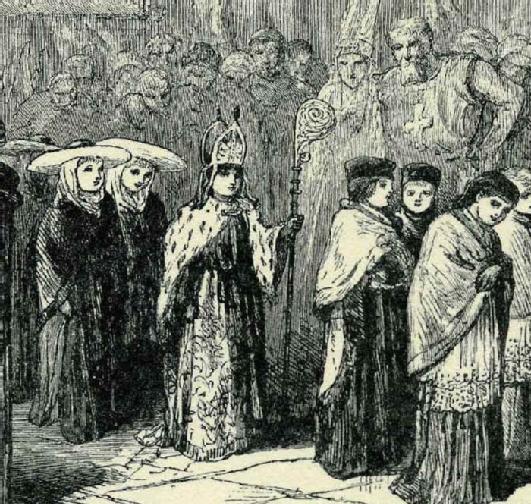Church Ales in the Middle Ages
Joe Chick (King’s College London and My-Parish webmaster)
The parish as it stands today has evolved significantly in terms of its function from how it stood in the medieval era. Nowadays, we are familiar with parish councils as a form of local government, handling matters like streetlights and bins in parks that have little to do with religion. This governmental role is something that they gained later, particular in the Tudor era. In the medieval times, the parish was purely an ecclesiastical unit and not a governmental one. At least, this is the case in terms of its official remit.

Figure 1: St Laurence’s church in Reading. Home to some of the town’s leading
civic officials and a venue for social activities. Picture by the author.
When we study the unofficial function of the medieval parish, it quickly becomes apparent that it was far more than a venue for religion. Parishes were also important social hubs for medieval communities. For many parishioners, the socialising at religious feasts was as important a part of being a member of a parish as piety. Parishes marked various religious feasts across the year. There was no strict calendar followed by all English parishes. Instead, each chose certain festivals on which to place more emphasis, such as marking the day of their parish’s own patron saint.
The activities associated with religious festivals were an important means for raising money for the parish. The way in which they were marked can be surprising to those unfamiliar with medieval popular piety. Making the celebration overly pious might not be the most effective way of getting parishioners to willingly part with their money. Instead, the emphasis was on making the festivals entertaining.
My own research has looked into the town of Reading in the fourteenth, fifteenth, and sixteenth centuries. The town was composed of three parishes. St Laurence’s was entirely urban, while St Mary’s and St Giles’ were formed of parts of the town and parts of the surrounding countryside. Their churchwardens’ accounts reveal a vibrant parish life. Some of the ways in which dates of the religious calendar were marked were far from spiritual.

Figure 2: Image of morris dancers with a hobby horse from c.1620. Courtesy of Wikipedia.
In principle, Whitsuntide marked the descent of the Holy Spirit. In Reading, as elsewhere, it was celebrated with a game called the king play, in which the social norms were inverted with one parishioner acting as a mock monarch. The play incorporated elements marking the new beginnings of spring and the St Laurence’s churchwardens’ accounts record the ‘carying of a bough for the king play at Whitsontyde’. The day was also accompanied with a church ale, involving morris dancing and feasting in the churchyard.
The parish acted as the venue for many other events, some of which made even less of an effort to present themselves as pious. One such activity was Hock Tide. It took place on the second Monday and Tuesday after Easter but marked no specific religious festival of its own. On the first day of Hock Tide, the women of the parish went around kidnapping the men and holding them ransom. The ransom money went towards funding the parish. On the second day of Hock Tide, the same activity took place, but with the men capturing the women.
Being used by some as an excuse for flirting, the activity does not really fit our expectations of religion. As with the king play, Hock Tide allowed for an inversion of social norms, in this case the patriarchy rather than the hierarchy of social status. In Reading, it was also accompanied by a Robin Hood play. After finishing the games, Hock Tide often ended with a church ale involving a feast with singing and dancing. In St Laurence’s, there may have been a division of the sexes for the feasting, with the accounts recording separately the ‘wyvis soper [supper]’ and the ‘bachelers soper’.
The organisation of events like Hock Tide could also be an opportunity to socialise in their own right. In some places, it was the women of the parish who had responsibility for organising activities such as these. This was the case in Reading. The churchwardens’ accounts for St Giles’ record the ‘soper of the wyves at hocktide’, held in return for their work.
Both Hock Tide and Whitsuntide were spring festivals, a peak time of year for church ales. They formed part of a longer calendar of parish activities described by Charles Phythian-Adams as ‘the ritual year’. Adams outlines a regular series of activities that began with Christmas and lasted through to midsummer. The particularly lively spring escapades, with their church ales, are sometimes called the summer games.

Figure 3: Nineteenth-century drawing of a boy bishop. Courtesy of Wikipedia.
We are currently in the advent season which was marked in quite a different manner from the spring. At least, that is the case until Christmas itself arrives. Advent was a time of fasting, but the tone changed for the twelve days of Christmas. A common activity at this time was the appointment of a King of Misrule, another inversion activity. The levels of subversion were sometimes seen as excessive, with a case of the king being based around Jack Straw, a rebel leader from the Peasants’ Revolt of 1381. Some parishes had an ecclesiastical version of the King of Misrule known as the Boy Bishop. In these parishes, the Boy Bishop would tour the area to collect donations from parishioners.
The beer and food festival at St John the Baptist Church in Berkswell resurrects the practice of a church ale. Some of the less restrained aspects of Hock Tide may not be included, but the parish taking the role of a social hub for enjoying food and drink is very much in a long-standing tradition of European parishes.
Bibliography
- Dils, Joan, ‘Redding 1540-1640: A Portrait of a Community’ (unpublished booklet, University of Reading, 1980).
- Dils, Joan (ed.), Reading St Laurence Churchwardens' Accounts, 1498-1570, 2 vols. (Reading, 2013).
- Duffy, Eamon, The Stripping of the Altars: Traditional Religion in England, c. 1400 - c. 1580, 2nd ed. (New Haven and London, 2005).
- French, Katherine L., The Good Women of the Parish: Gender and Religion After the Black Death (Philadelphia, 2008)
- Hutton, Ronald, The Rise and Fall of Merry England: The Ritual Year, 1400-1700 (Oxford, 1994).
- Johnston, Alexandra F., and Sally-Beth MacLean, ‘Reformation and Resistance in Thames/Severn Parishes: The Dramatic Witness’, in Katherine L. French, Gary G. Gibbs, and Beat A. Kümin (eds.), The Parish in English Life, 1400-1600 (Manchester, 1997), pp. 178-200.
- Nash, W.L. (ed.), The Church-Wardens’ Account Book for the Parish of St. Giles, Reading, Part 1 1518-46 (Reading, 1881).
- Phythian-Adams, Charles, Desolation of a City: Coventry and the Urban Crisis of the Late Middle Ages (Cambridge, 1979).
- Rixon, Peter, 'The Town of Reading, c.1200-c.1542', unpublished DPhil thesis, University of Oxford (1999).
- Swanson, Robert N., Church and Society in Late Medieval England (Oxford, 1989).
Biography

Joe Chick is a historian of urban society who completed a PhD at the University of Warwick in 2020. His research looks into urban society across the traditional medieval and early modern divide, covering the fourteenth, fifteenth, and sixteenth centuries. He currently teaches medieval history at Warwick and is a research assistant on a Wellcome-Trust project at King’s College London which looks at health in Victorian and Edwardian Britain.
FEAST!
This blog post was specially commissioned for - and co-launched by - the FEAST! theme in the University of Warwick's Resonate Festival for Coventry UK City of Culture 2021. For further information on associated events / contents please visit the FEAST! website and for an introduction to the Berkswell church ale watch this short video.
